January 6, 2022
Permaculture Garden Design: Suthi and Sanjay Nagar
On a sweet late October morning, at last we met Suthi Picotte Nagar in her permaculture-inspired front yard, where enthusiastic pollinators frolicked among beneficial herbs and fall-blooming splendor.
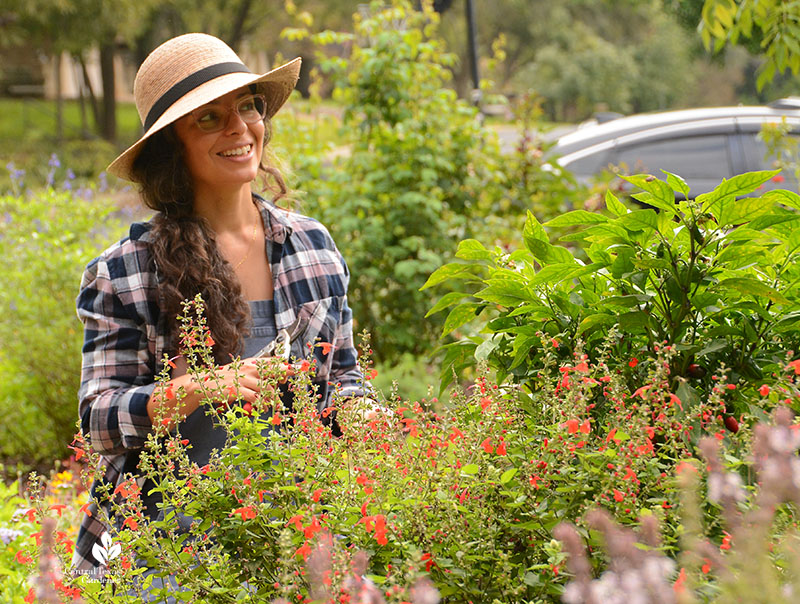
When she and husband Sanjay Nagar arrived in Austin with their young daughter, they loved their neighborly street.
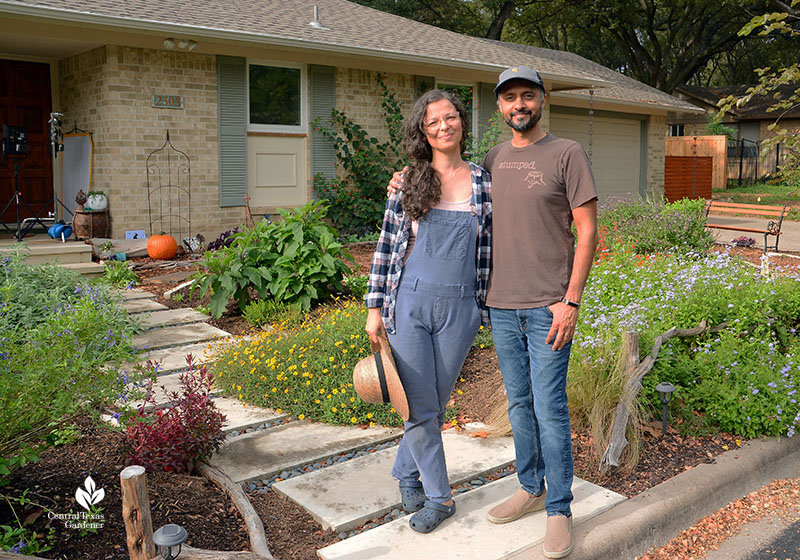
But her growing vision went far beyond the yard’s skimpy lawn and shrubs. New to Texas and new to gardening, too, she needed help to figure out Central Texas challenges.
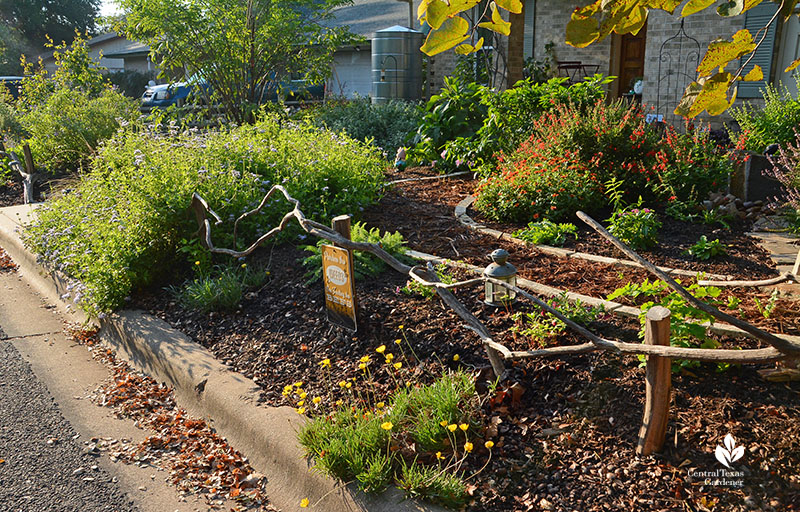
“Early 2016, we moved here from Pasadena, and I spent the first year observing, just what’s the weather like, when does it rain? How does the water flow on the land? Summer sun versus winter sun,” she said.
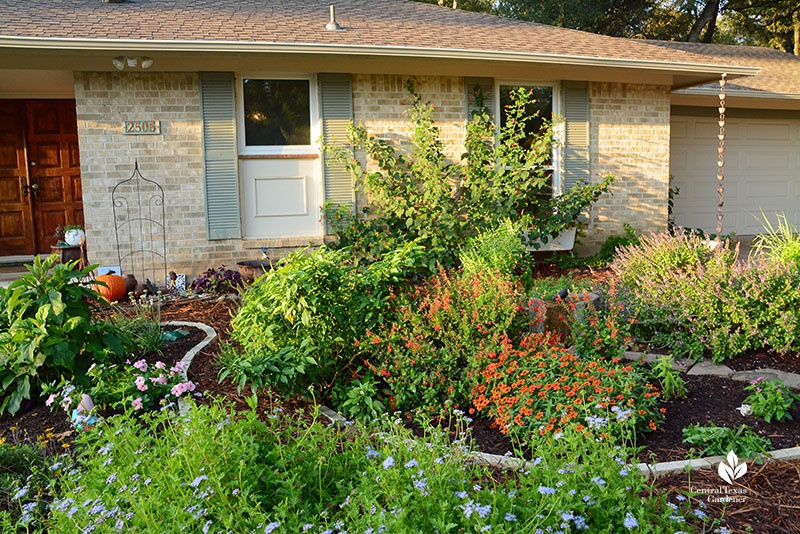
She signed up for a class with the Austin Permaculture Guild to learn how to work with the environment, rather than trying to dominate the land. She volunteered for permablitzes, where gardeners get together to accomplish a project. Suthi submitted her yard, and when it was accepted, “My parents flew in to feed everybody. We had 30-plus volunteers and we sheet mulched everything. So, we put cardboard down and compost and mulch, and we went from all grass, and a dying crape myrtle, to a brown space, which sat all winter. I think my neighbors were worried,” Suthi said.

When the troubled crape myrtle simply had to go, Suthi kept its sculptural branches in honor of its place in their yard’s story. She and a friend sourced mountain cedar posts from another friend, and she built a loose, gentle “fence” to define her new garden.
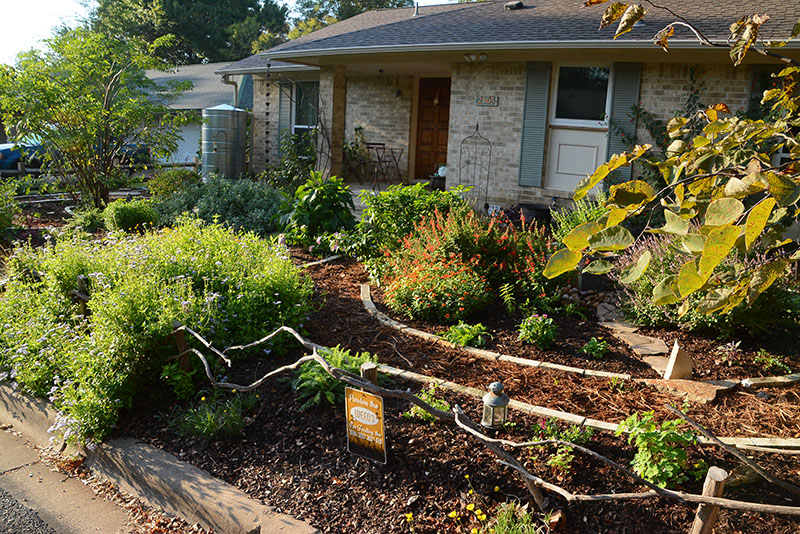
Inspired by circles, she centered one design around a medicine wheel-inspired flower bed that points north, south, east, and west. Around the year, clusters of seasonally flowering perennials and annuals promise herbal harvests, lively beauty, and food for pollinators.
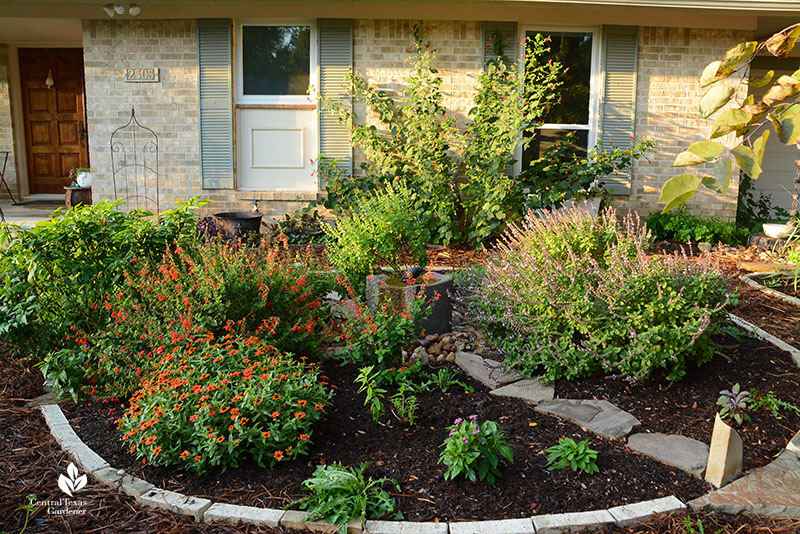
On our October visit, thyme, several basils, lemon balm, sage, jalapenos and eggplant companion with native Salvia coccinea, zinnias, and African blue basil. In this view, native Gregg’s mistflower joins in from its curbside spot.
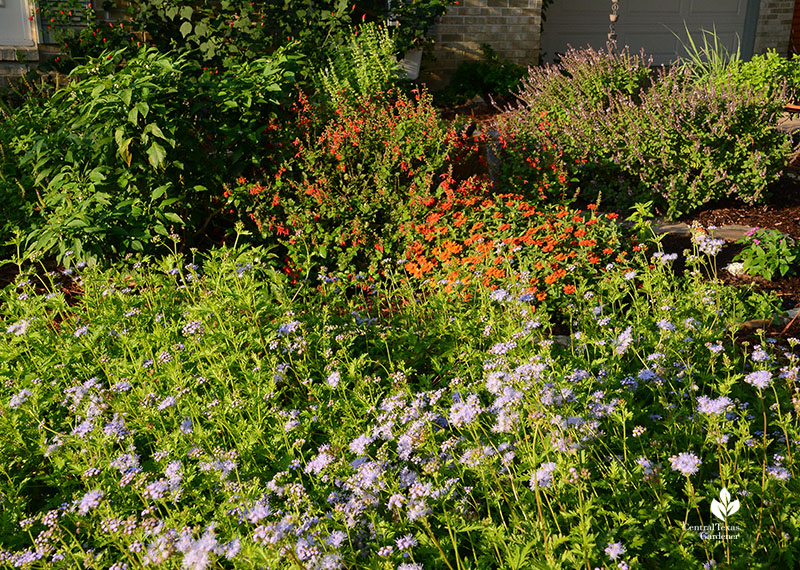
Since water means life, and our wildlife need it as much as we do, she saved up to add a small, bubbling fountain, where thirsty birds perch every morning. “And they look so happy, it really makes my heart sing,” she said.
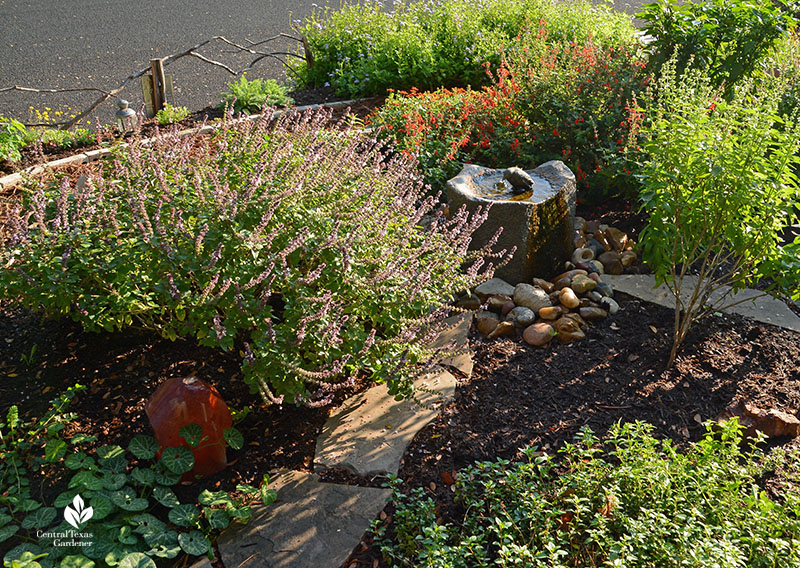
She added small stones so that bees can grab a safe drink after flocking to the tropical sage (Salvia coccinea) and African blue basil. Families of toads hang out at the watering hole, too, along with anoles and docile wasps.
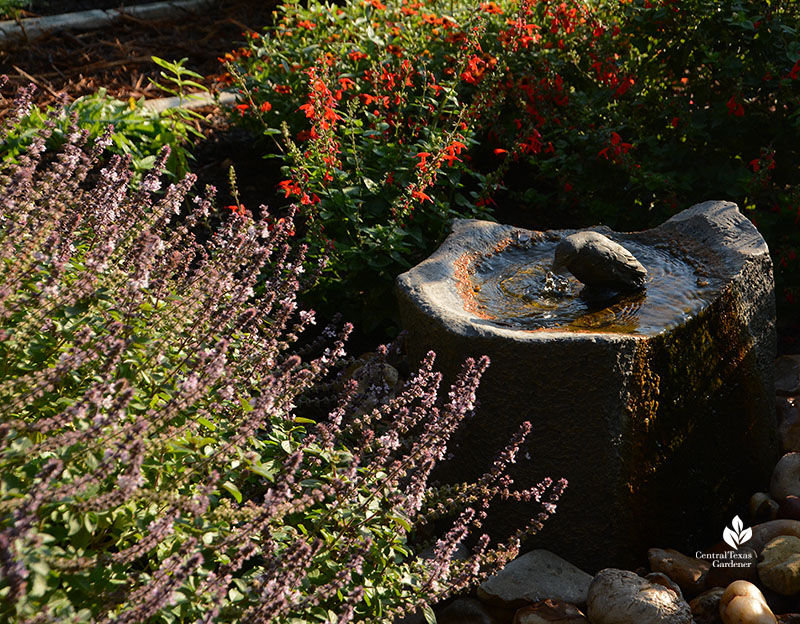
Even in this small yard, she’s followed an element of permaculture known as stacking functions. “And it means that one thing does multiple things, you stack the function. And to me, beauty is a function, so I always pick things that I find aesthetically pleasing,” Suthi said. This view features native native mealy blue sage (Salvia farinacea), native Zexmenia, Gregg’s mistflower and Mexican feather grass.
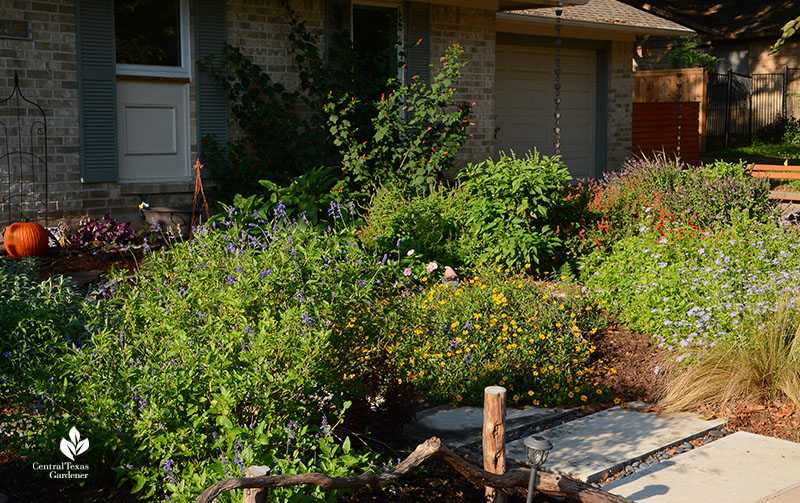
“But then I would love it if they are native, or they’re drought tolerant, or they are good for hummingbirds, or bees, or they are a dense shrub that allows birds to make a nest.” Dwarf pomegranate joins a rose, native apricot globe mallow and Zexmenia along this curb.
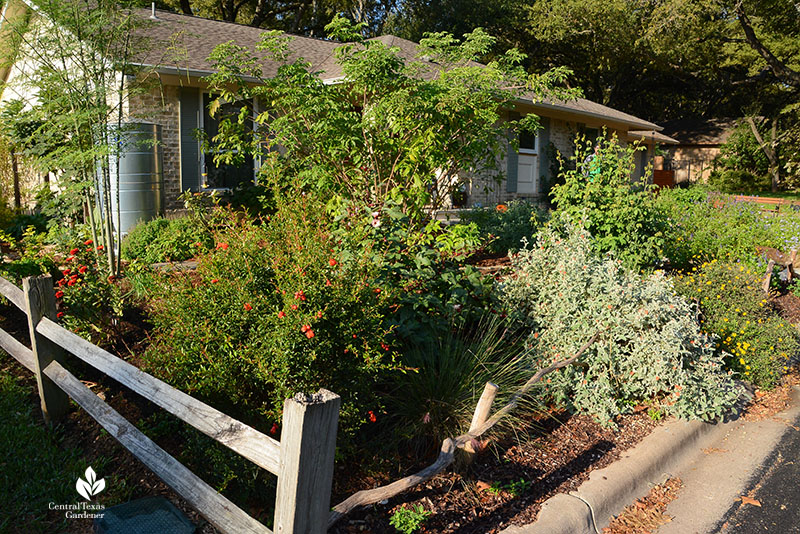
“And then it’s also a bonus if it’s medicinal, or it produces fruit that humans can eat. I just like everyone to have multiple jobs, that we can all work together and be efficient.” As we taped, she gathered a fragrant basket of peppers, chile pequins, sage, hibiscus calyxes, basil, and eggplant.
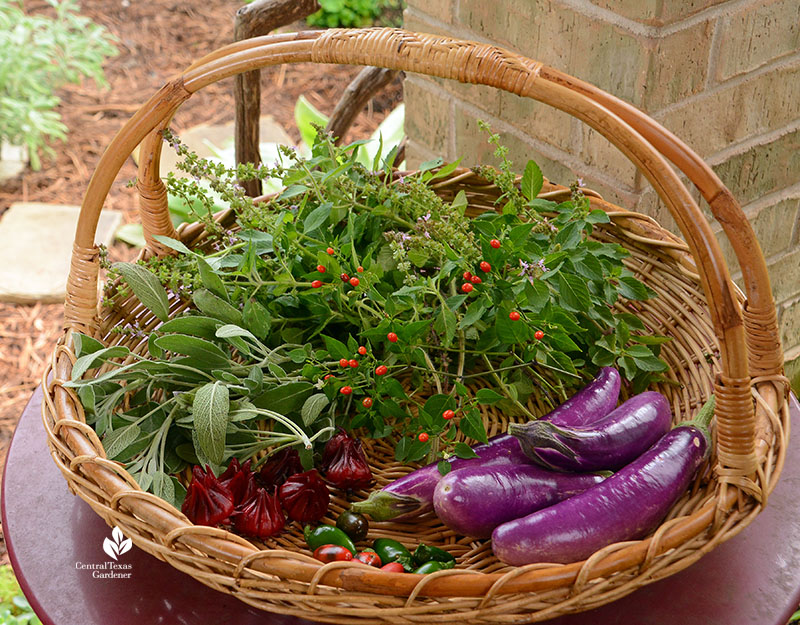
Her paths for walk-around discovery contribute dimension and definition. She bordered the new beds with bricks repurposed from the former front door sidewalk.
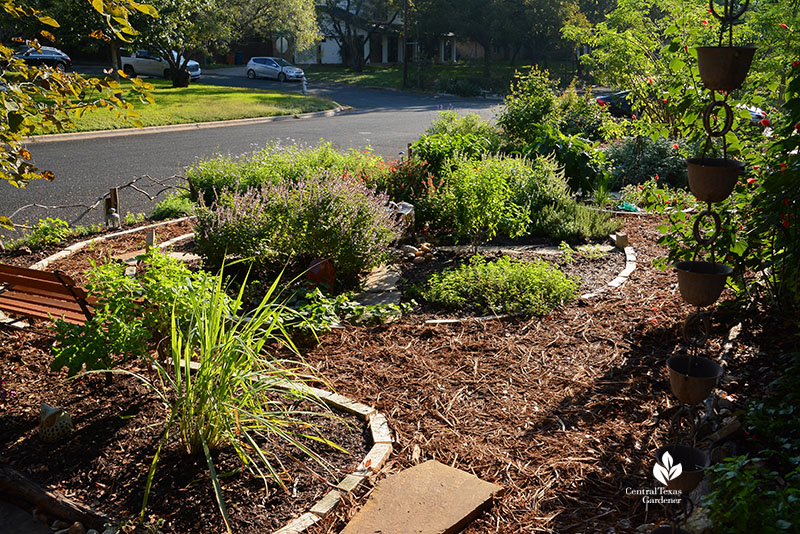
Instead of strict rows of foundation plants, she invites perusal among low-growing herbs and a ‘Big Momma’ turk’s cap that draws hummingbirds and butterflies to window view.
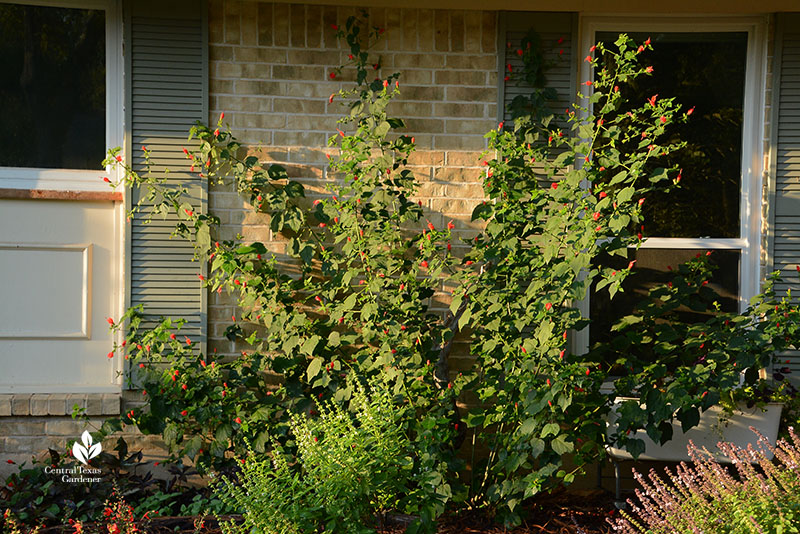
She made her main pathways wide enough for a wheelbarrow, but she did go narrow around the beds to maximize plant space.
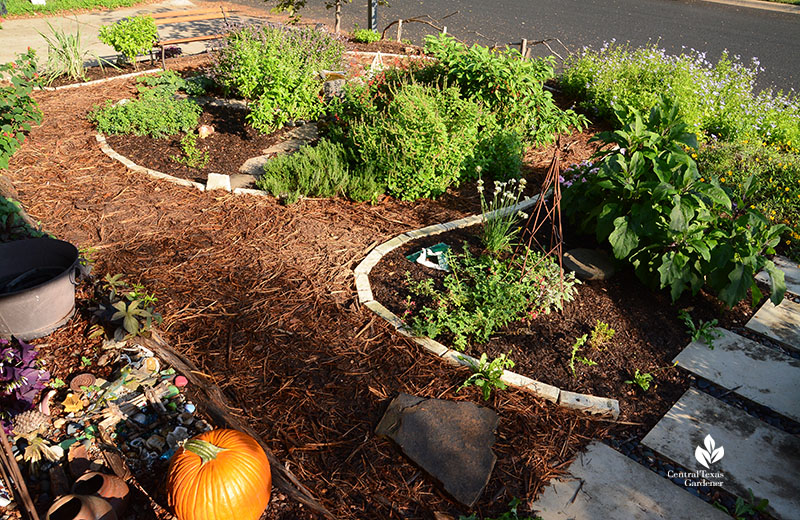
She did add stepping stones to access across the beds without compacting the soil.
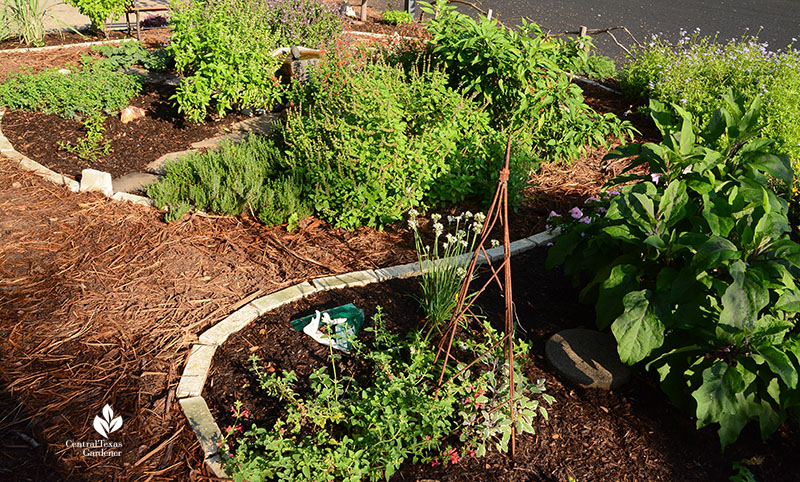
To get to the front door on sturdier footing, they replaced the rocky brick path with sturdy staggered slabs of Lueders limestone. Fragrance and dazzling color enliven every footstep.
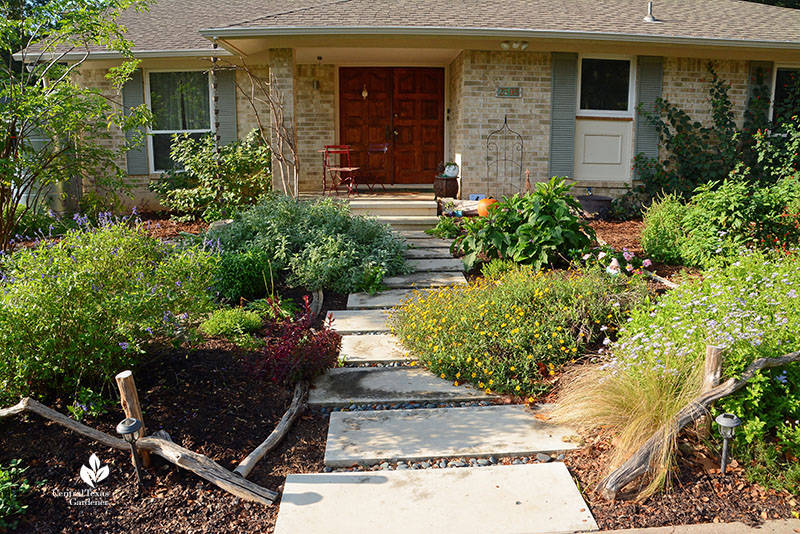
Since Suthi’s learning what individual plants need, she may buy three of each to understand their sunlight preferences across the year, making adjustments per their response.
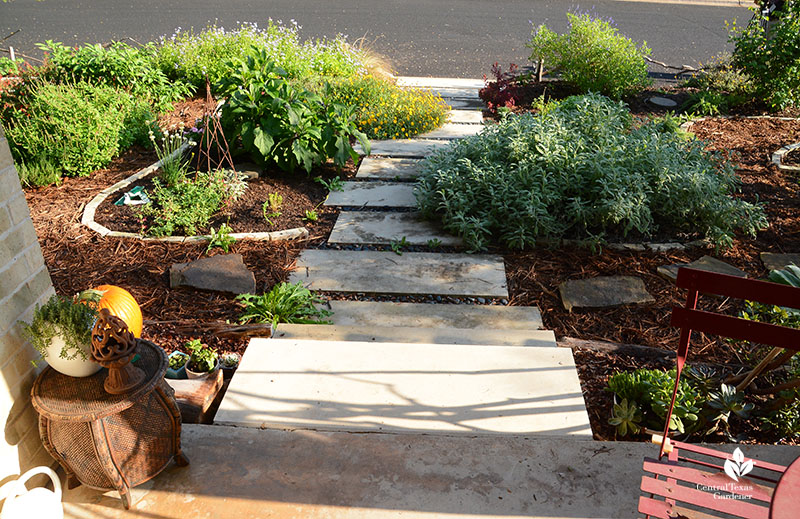
In her Certified Wildlife Habitat, most of her plants feed pollinating insects, along with hummingbirds and the songbirds that feed on seeds and fruits.
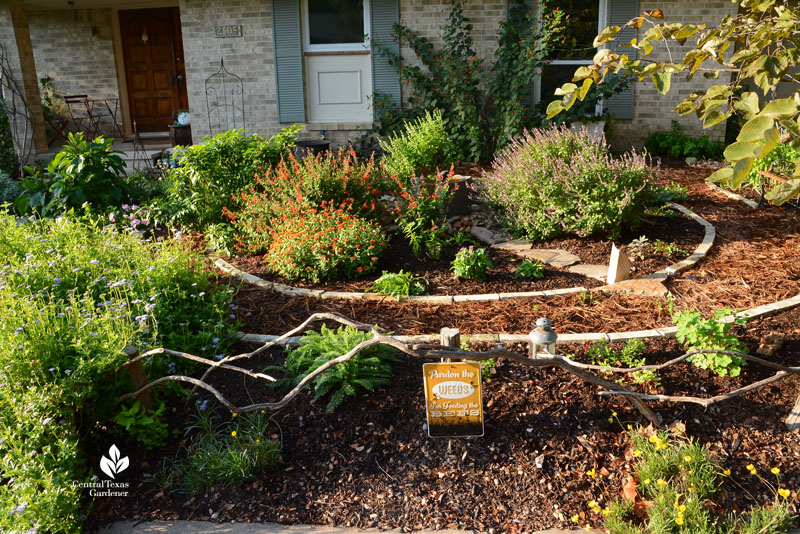
Boisterous native perennial Gregg’s mistflower was the first plant she bought. In fall, dozens of butterflies delight every child in the neighborhood. Last summer, she added native Salvia coccineas that return after winter from roots or seeds, and annual summertime zinnias that support bees and butterflies until Gregg’s mistflower kicks in.
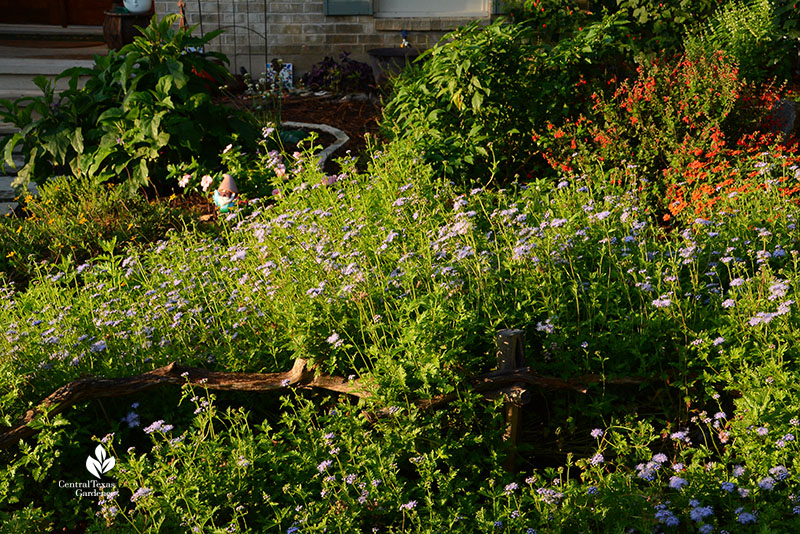
“Because we’re taking up their space as the city grows, I’m just trying to give back a little bit,” Suthi said.
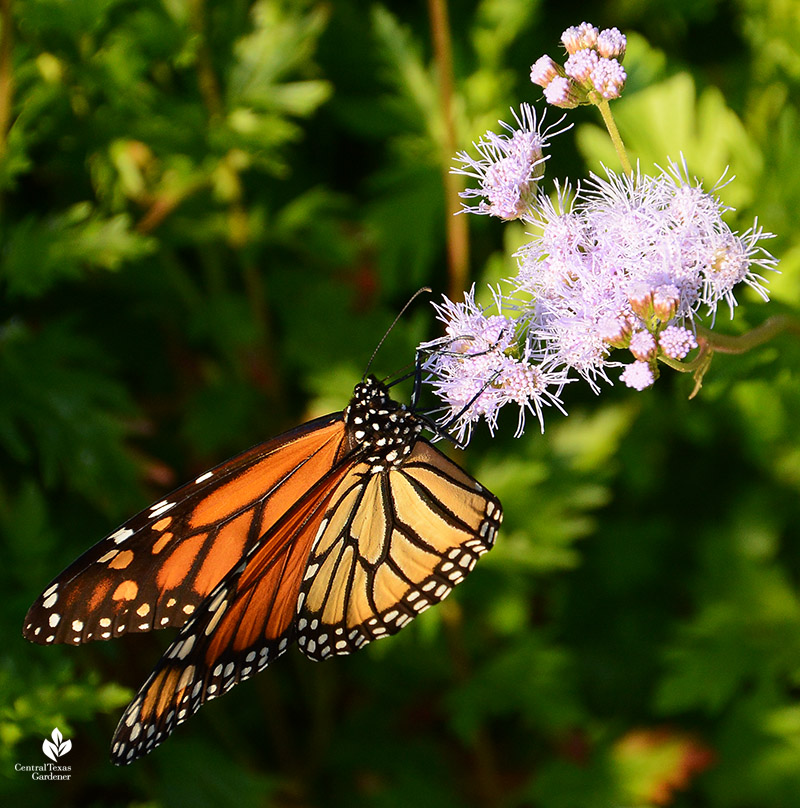
Pollinators love annual Hibiscus sabdariffa—the Roselle hibiscus—known for soothing hibiscus tea. We make tea from its deep wine-red calyxes, but we can also eat them. “They’re delicious, and they’re really good for the whole cardiovascular system,” Suthi said.
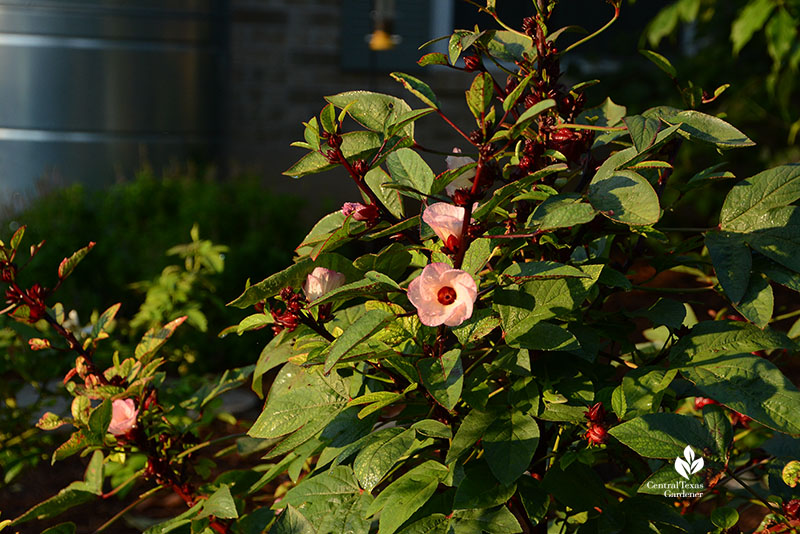
She anchored that side of the garden with an elderberry tree and what turned out to be a great surprise: a very tall moringa tree! When a friend passed along seeds three years ago, she poked one into the ground and then forgot about it.
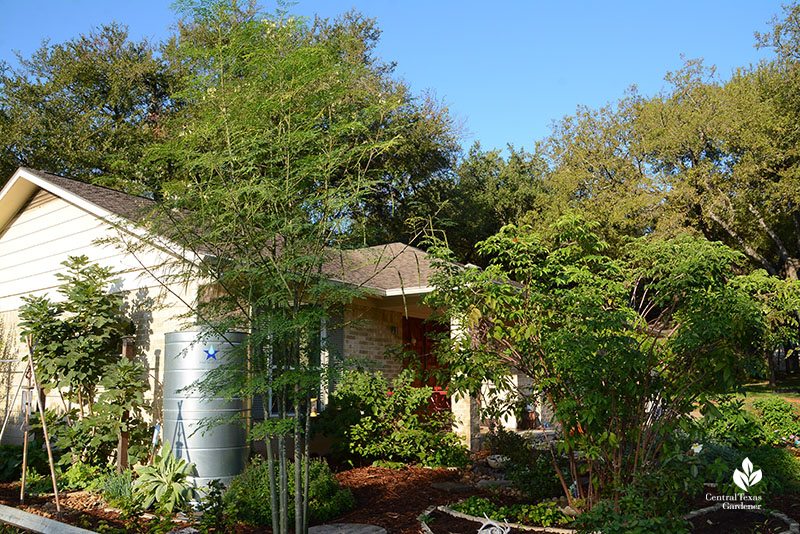
Now 15’ or so tall, its flowers herald hummingbirds and pollinating insects. Beneficial as a food for us, too, she dries the leaves for teas and recipes.
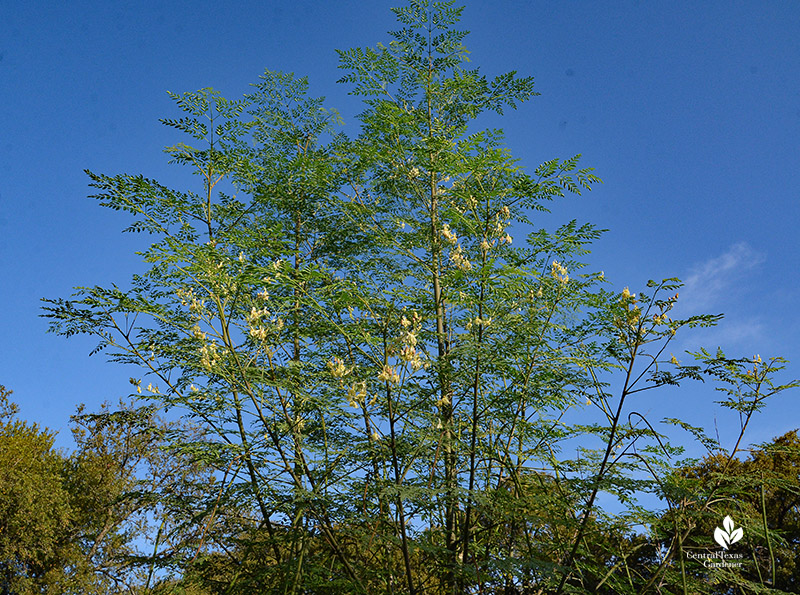
Their young daughter prompted Suthi’s interest in learning what plants are safe to eat. In her Austin Permaculture Guild class led by Caroline Riley of Cultivate Holistic Supply Homestead, Caroline showed how to make medicine from plants (CTG story coming this spring).
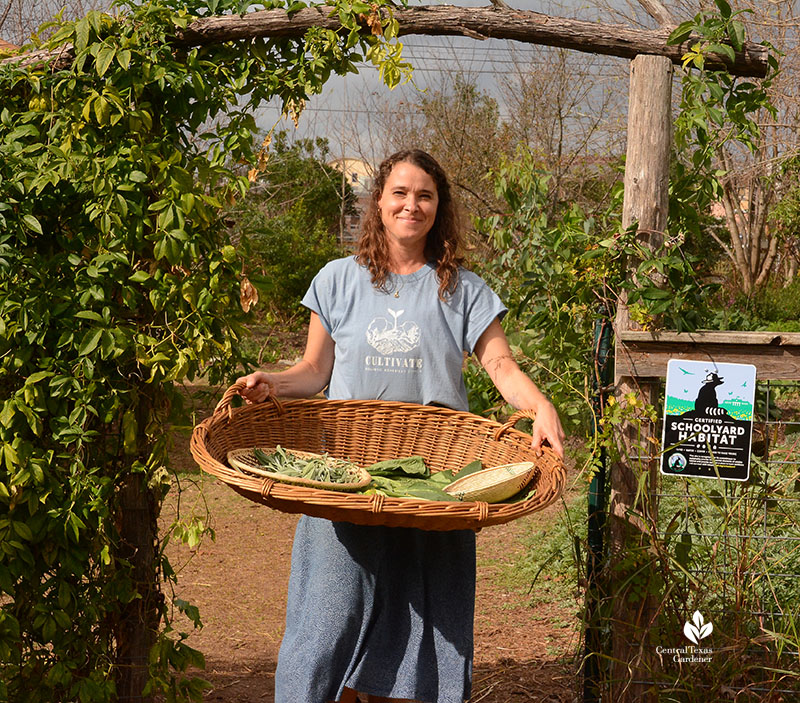
When Suthi learned that elderberry flowers can be infused in honey with yarrow and peppermint to help sweat out a fever, she planted her tree. Last fall she harvested four one-gallon bags of elderberries to make syrup for the neighbors. Recognized for its antioxidants and vitamins, elderberry can soothe flus and colds; you’ll often find it at drug stores!
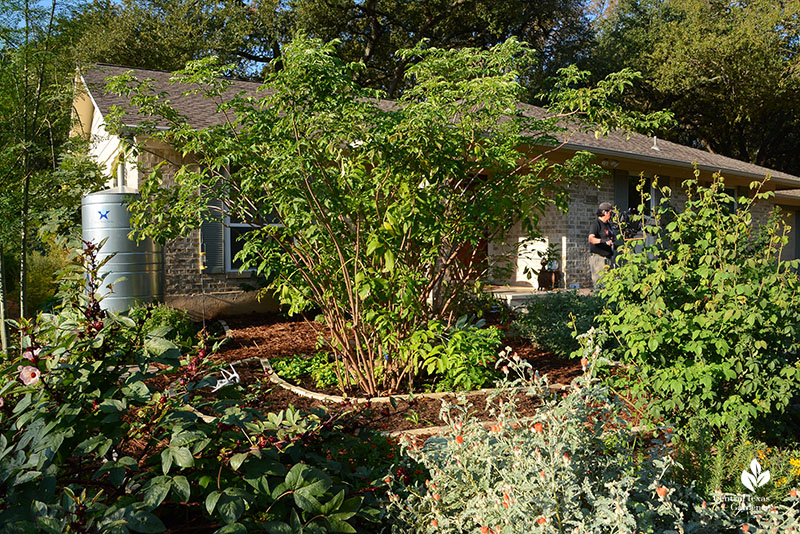
Since it does like some extra moisture, she dug a rain garden for it on the yard’s downward slope. A rain chain also directs rainwater, while a cistern collects it.
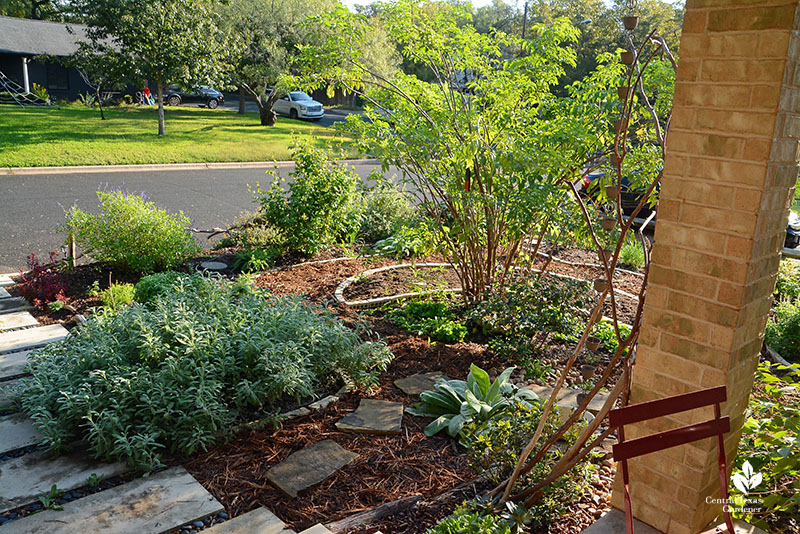
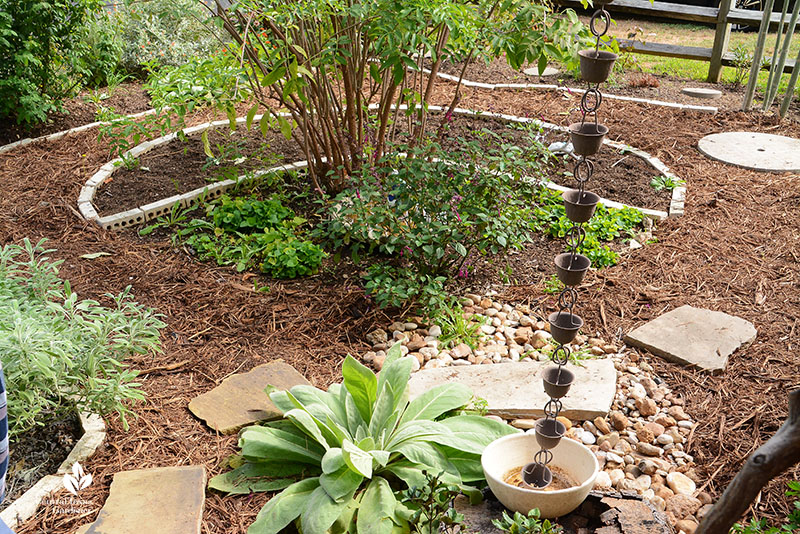
This garden’s as much for their convivial neighbors as for the family. In fact, I’m deeply grateful to one of them—Camille Feliz—who connected us all! Suthi’s always ready with her pruners to clip fresh herbs or pass along cuttings and seeds. “When people walk by, I want to give them a place where they know that they can take a deep breath, and they can feel grounded a little bit,” Suthi said.
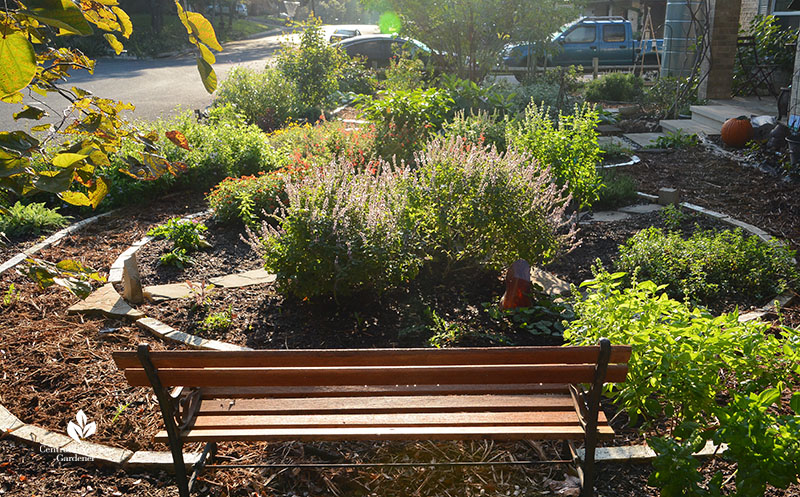
Suthi’s journey led her down a new path to study as a functional herbalist, now offering health and wellness consultations, permaculture-inspired garden design, and small class instruction. Follow her progress @lady.chickweed. “Find your happy space, and if it’s in the garden, awesome!”
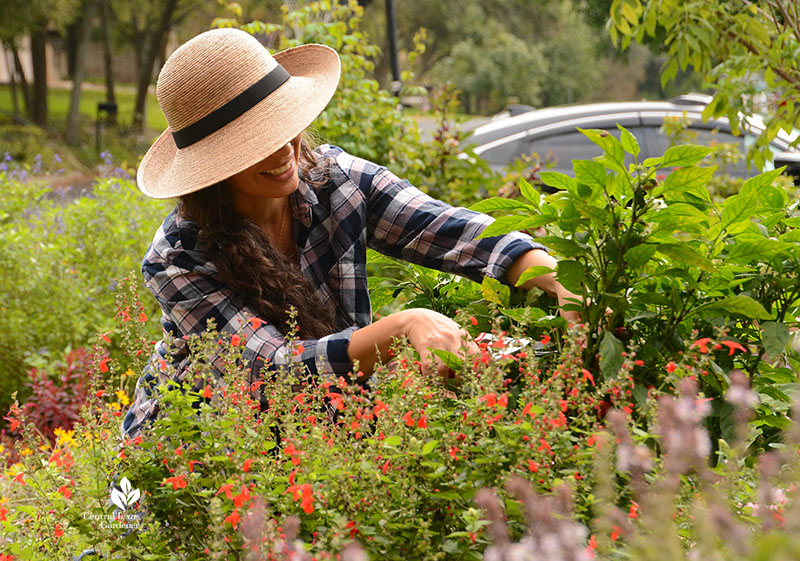
Watch the whole story!
Thanks for stopping by! Linda

